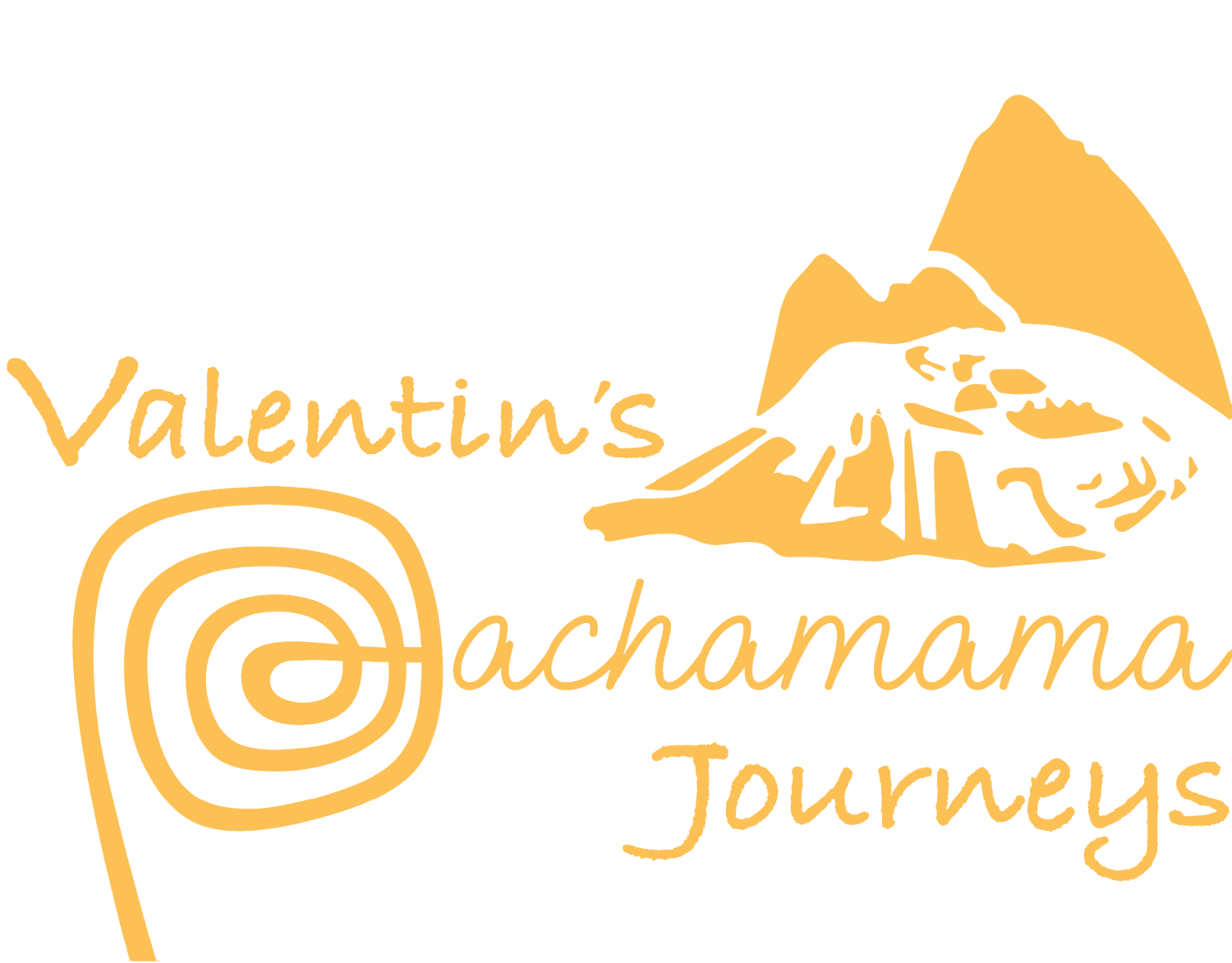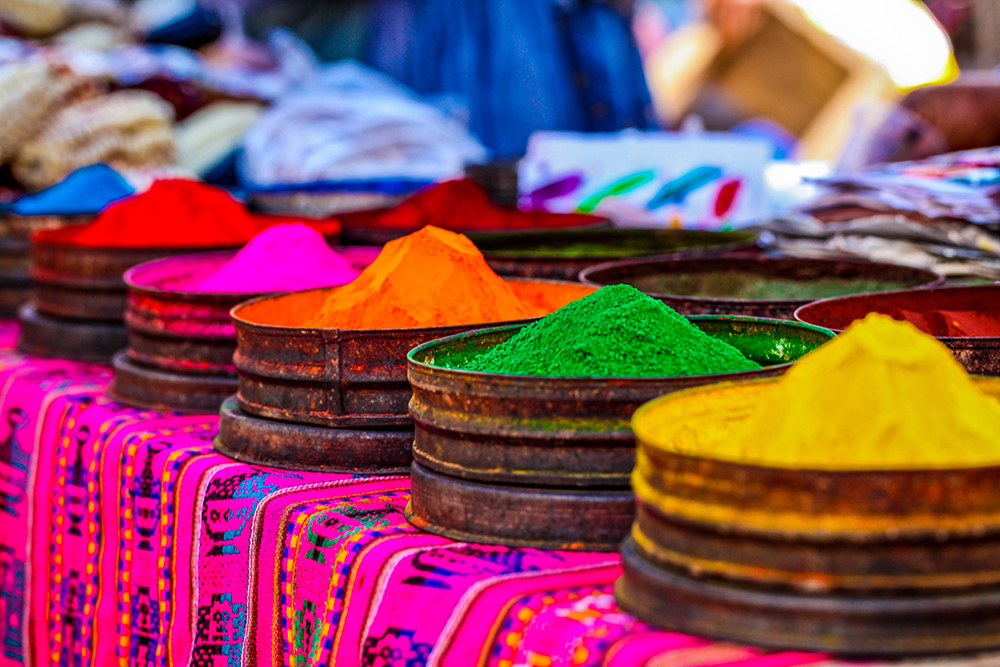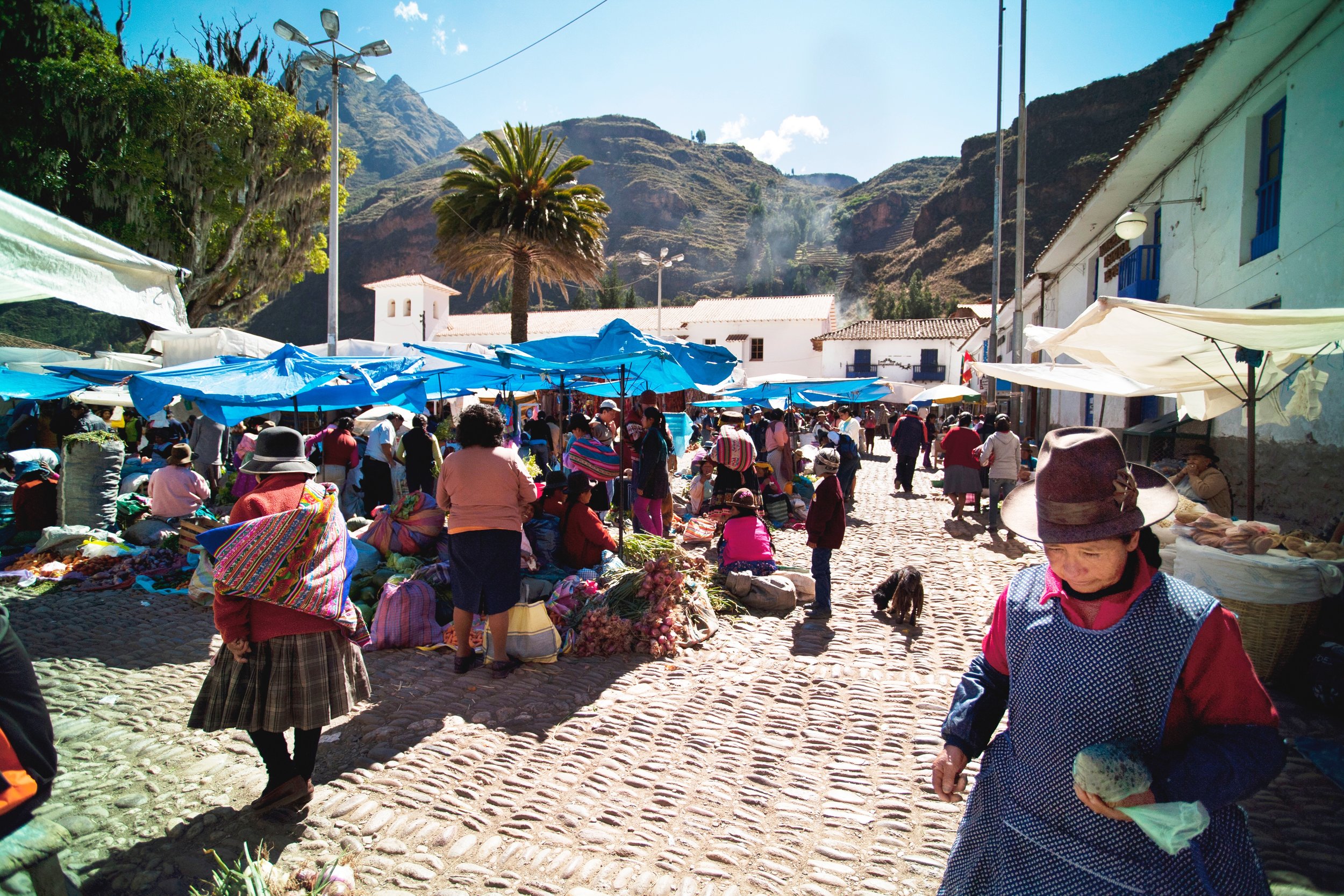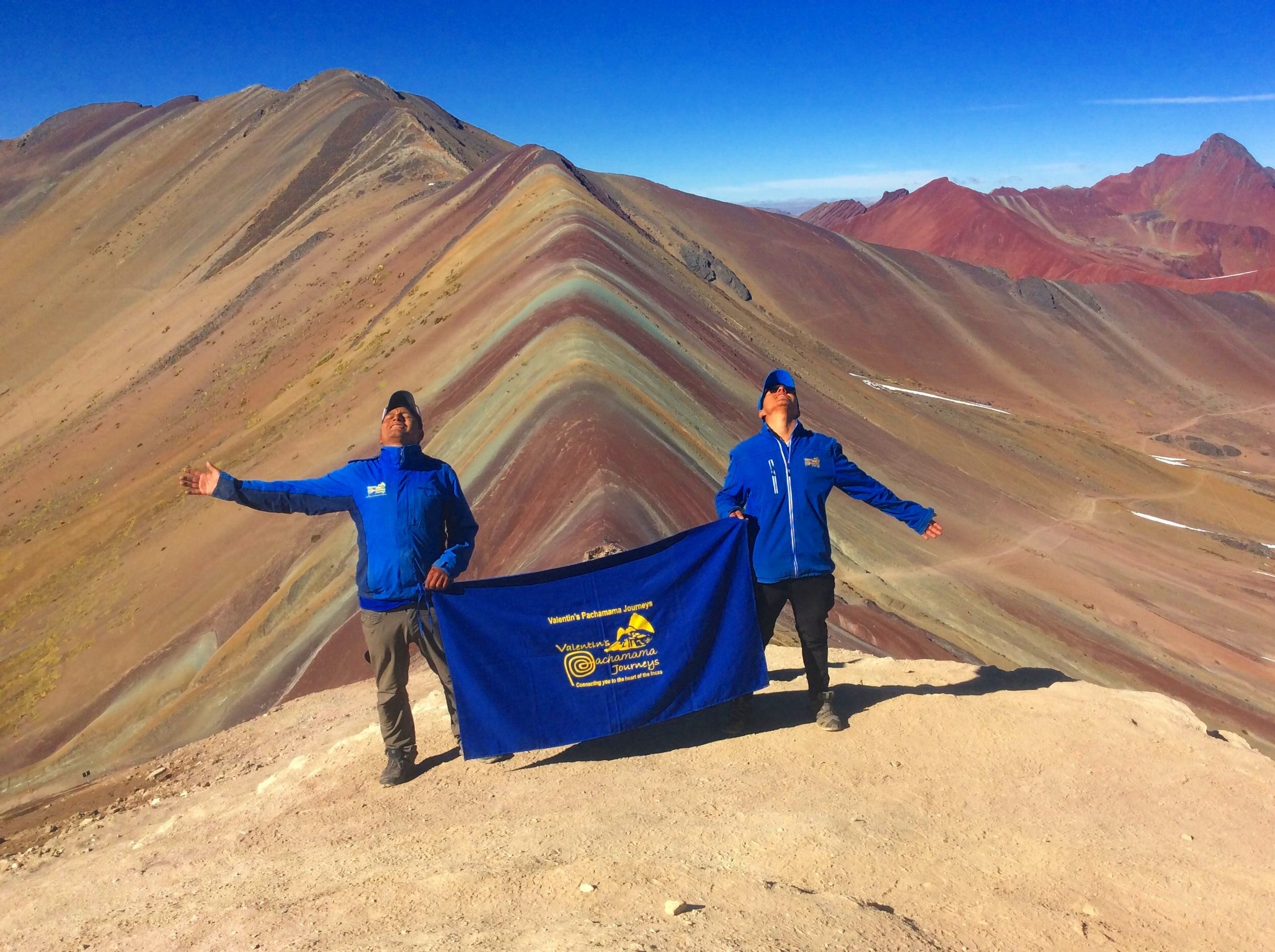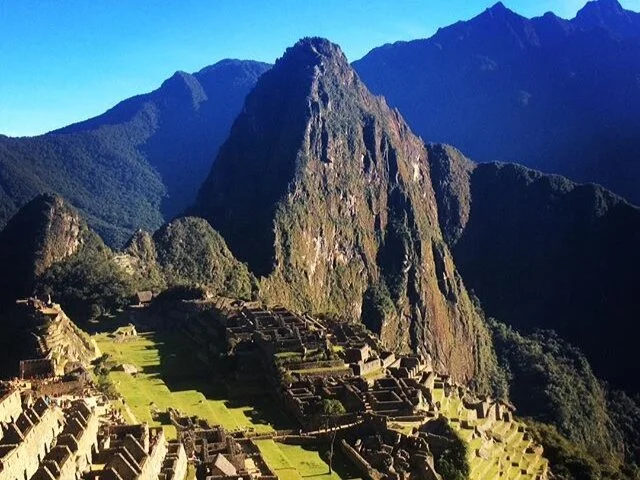A few of the hundreds of potato varieties at the Potato Park, Parque de la Papa
Pisac Ruins & Potato Park (Parque de la Papa)
Potato Park, Parque de la Papa
The Potato Park, Parque de la Papa, is a community project dedicated to celebrating and protecting Peru’s favorite tuber, the potato.
Peru is home to over 4,000 distinct potato varieties. Remarkably, the Potato Park boasts 1,367 native potato varieties!
Our Potato Park tour highlights the remarkable conservation efforts undertaken by these five Andean communities in the Sacred Valley. Guests can learn how tubers helped protect and shape Peru’s past and inspire its future.
Sustainable agriculture, biodiversity protection, and supporting women's collectives are all integral to the Potato Park's remarkable journey.
The locals call this concept Sumaq Kausay, which translates to Andean wellbeing, celebrating a harmonious existence through complementary, reciprocal, and balanced agriculture. This guiding principle connects Andean realms of living creatures, wild spaces, and sacred mountains.
Potato Park and Pisac tour
The Parque de la Papa is not just a Peruvian potato tasting experience. Immerse yourself in the local communities’ sustainable farming practices. Try traditional food like pachamanca, help with harvests, and learn about quinoa and other Andean crops.
Local farmers, the guardians of ancestral knowledge, guide you through the story of the potato and its impact on Peru's legacy to the world. Stroll through history and fields packed with a fantastic array of potato colors while supporting the local community.
A few of thousands of varieties of Andean potatoes
Potato Park Highlights
Here are some of the highlights to enjoy at Peru’s Potato Park.
Immerse yourself in sustainable Andes farming
Help Quechua communities preserve their traditional farming ways
Participate in harvests
Discover the world-changing impact of Peru’s 4,000+ potato varieties
Learn the magic of chuño, a freeze-dried potato vital to mountain life
Understand the deep spiritual connection between locals and the land
Protect biodiversity and cultures with your visit
Boost climate-change resilience through ancient techniques
Explore the incredible Inca ruins at Pisaq
Watch the ancient pachamanca cooking technique—then try this delicious food
People in traditional dress at Pisac’s Potato Park, Parque de la Papa
Potato Park: A Quick Overview
Duration: 1 day
Difficulty: Easy, with some slopes to walk
Guide: Professional, licensed English-speaking guide
KM zero: 100% local licensed company.
Altitude: 3,150-4,600m (10,334-15,154 feet)
Starts: Cusco/Ollantaytambo
Ends: Ollantaytambo/Cusco
Meals: Lunch (vegan, vegetarian, gluten-free, and more dietary requirements available)
Departures: Daily
Acclimatization: We recommend at least two nights in Cusco or a similar location immediately before starting.
Group Size: Max 10 people
Best Season: Year-round
Price: From $155 per person
Payment: We accept PayPal and Visa
A variety of potatoes in a pachamanca
“Spending so much time with Valentin, Kenny, and Roger was so wonderful. We learned so much on our tours, not only about the sites we were seeing, but also what life is like living in Peru. Valentin is so knowledgeable on the area and you can tell he is proud of where he comes from, and rightfully so. The food prepared by Roger was phenomenal. Everything tasted so fresh, and you could tell how much time and attention went into preparing it.
I cannot say enough good things about this company.
”
Potato Park & Pisac Outline Itinerary
Day 1: Drive to the Potato Park, El Parque de la Papa → Guided tour of the Potato Park → Specially selected picnic lunch (pachamanca) featuring a variety of potatoes → Pisac ruins tour including an Inca tunnel → Return transfer to your hotel, ends
Remember, you can start or end your trip in Ollantaytambo, Cusco, or other destinations in the Sacred Valley.
Top acclimatization tips: Walk slowly, avoid sudden movements, drink coca tea, stay hydrated, and avoid alcohol, caffeine, and heavy meals.
Potato Park Timings
08.00 Transfer from your hotel to the Potato Park
10.00 Guided tour of the Potato Park
1 p.m. Potato-themed picnic lunch and pachamanca
2 p.m. Guided tour of Pisaq ruins and market
4 p.m. Transfer back to your hotel
Potato Park & Pisac detailed itinerary
Located in the heart of the Andes mountains, above the town of Pisaq, is the community-run Potato Park, Parque de la Papa.
It takes 90-120 minutes to drive from Cusco to the park entrance at Pampallacta, where we begin our tour.
Potatoes in the Andes
There are more than 4,000 varieties of potatoes throughout the Andean regions of Peru.
The Parque de la Papa is an agricultural park dedicated to preserving the biodiversity of the more than 1,350 varieties of potatoes cultivated in the area since Inca times. Pampallacta celebrates the potato, highlighting its central role as a global biodiversity hotspot.
So important is the Potato Park that its seeds form part of The Svalbard Global Seed Vault, located in Norway, a food safeguard in case of natural or climate change disasters.
Watch Adam Kerby’s short documentary about indigenous farmers from Bhutan and China visiting the Potato Park.
Did you know? The Potato Park aims to protect IBCH—Indigenous Biocultural Heritage—to sustain local jobs, customs, and biodiversity.
There are more than 4,ooo potato varieties in the Andes
Potatoes as medicine?
The six local communities—Sacaca, Chawaytire, Kuyo Grande, Pampallaqta, Paru Paru, and Amaru—will explain how potatoes are vital for food, medicine, and technology. They'll explain their hopes that preserving their ancient traditions will protect the future of their 6,000-strong population.
Walk beneath towering Andes mountains and stroll the verdant Sacred Valley as your guide describes the spiritual connection the communities have with their land and crops.
Celebrate Indigenous Culture: Experience Andean hospitality firsthand through traditional ceremonies, pachamanca cooking, and storytelling. This makes the Potato Park a living museum.
Enjoy unique biodiversity on walks through rare Andean flora and fauna found nowhere else on Earth.
Explaining irrigation and sustainable farming at the Potato Park
Activities at Parque de la Patata
More activities in Parque de la Patata can include (please ask in advance):
Cultural immersion: Connect with Quechua traditions through local guides, food, and agricultural techniques.
Traditional food tastings: Enjoy potatoes, quinoa, and other locally sourced ingredients.
Agricultural experiences: Join in planting or harvesting, depending on the season, and savor the fruits of your labors with locally prepared food: potatoes, quinoa, maize, and more.
Guided hikes: Explore the Andean wilderness and stunning landscapes from cloud forest to high mountains, each with unique flora and fauna.
Wildlife: Keep an eye out for condors, eagles, and hummingbirds in the skies, with alpacas and more on the hillsides.
What is pachamanca?
Pachamanca is a traditional Peruvian cooking method where food is cooked underground in a pit. Heated stones warm the ingredients in a culinary ritual that often connects people with their harvests and nature.
You’ll get the chance to try a traditional pachamanca as part of the Potato Park day. Vegetarian, vegan, gluten-free, and more pachamanca options are available.
To start, a pacha (Earth) and manca (pot) involve seeing a pit dug and lined with heated stones. Typically, marinated meats, such as lamb, chicken, and pork, are layered with vegetables like potatoes, corn, and sweet potatoes. Leaves protect the ingredients as soil is layered on top of the pit to seal it, allowing the cooking process to occur.
Pachamanca (earth pot) also celebrates Pachamama, or Mother Earth, a clear sign of the Incas' strong bond with the natural world. There are rituals to follow to show gratitude for what Pachamama has provided.
Pachamanca ritual, Potato Park, Peru
The grand tradition of Chuño: life-saving potatoes
Chuño is a unique and traditional Andean method for preserving and enjoying potatoes.
Farmers expose bitter, frost-resistant potatoes to freezing temperatures at night, then intense Andes sun during the day. The freeze-drying process removes moisture, lending the potatoes a mild and earthy flavor that makes long-term storage easier.
Cooks then rehydrate the potatoes, which some find to be a little chewy. That said, chuño’s flavor-absorbing qualities make it ideal for stews and soups. Chuño has helped high-Andean communities survive in harsh conditions, especially when fresh produce is scarce.
There are even different colors of chuño: black chuño and white chuño. Each is rich in calories and carbohydrates and contains iron and calcium.
Guided tour at Pisac Ruins
Next, it's time to burn off the energy that the pachamanca has gifted with a tour of the Pisaq ruins and markets.
Pisaq, also known as Pisac, features majestic ruins and views from its terraces. These ruins served a variety of important functions, including religious, astronomical, and military purposes. Highlights at the Pisac Archaeological Park include:
Qantus Raqay: Residential and military area featuring terraced structures.
K'alla Q'asa: A large zone with towers and a short tunnel.
Intiwatana: Pisac’s principal ceremonial and religious area with a carved ritual rock, a sun observation building, and temples.
Terraces: Extensive agricultural terraces.
Cemetery: The largest Inca cemetery in South America is at Pisac.
Towers: Numerous observation and communication towers, known as pucaras.
We’ll also see water management systems, a seldom-used Inca Trail, and a tunnel before making our way to Pisac market.
Inca Terraces at Pisac, Sacred Valley, Peru
Pisac market tour
A Pisac handicraft market tour is the ideal spot to find souvenirs.
Browse ceramics, jewelry, and woven items abound. Feel free to haggle when buying anything from textiles like ponchos and blankets to alpaca scarves and hats.
There are some delicious Peruvian drinks and snacks to try as you weave around the various stores. Sunday is traditionally the busiest day, and Tuesdays and Thursdays also feature craft fairs.
Remember your camera: Pisac market is perfect for photo opportunities.
Check our FAQs, which cover altitude, money, and more, as well as our other programs, such as Cusco city tours or the Inca Trail.
Textiles and souvenirs for sale at Pisac Market
Potato Park Prices
Minimum 2 people
Groups of 2: $185 per person
Groups of 3 or 4: $175 per person
Groups of 5 or 6: $155 per person
What’s included?
Private transport, lunch, entrance to Parque de la Papa,& private tour with an English-speaking guide
What’s not included?
Entrance to Pisac covered by Boleto turistico: 130 soles-$40 covers entrance to Pisac, Ollantaytambo, Chinchero, Moray, multiple museums in Cusco, & Sacsayhuaman or 70 soles--$23, which covers only some of these sites
Why choose us?
Local, licensed expert guides
We liaise with the Potato Park communities for a personalized experience
Eco-conscious and culturally respectful staff for small private groups
Choose vegan, vegetarian, gluten-free, or other dietary options
24/7 support in Cusco and the Sacred Valley
FAQs about Potato Park & Pisac Ruins Tour
-
The Potato Park is a living museum. Local, indigenous communities preserve and share their knowledge through storytelling, farming, and real-life experience at the park.
-
Yes, many of the local families are happy to sell souvenirs to visitors. Gifts range from food and drink to ceramics and textiles.
-
We need to pre-arrange your visit to the Potato Park as it only opens with prior arrangement, usually between 9am and 3pm.
-
Our guided tours make a visit to Potato Park even more enriching. We'll organize the logistics, the opening of the park, a pachamanca, and more.
-
The Potato Park features a car park, restrooms, a visitor centre, and restaurant facilities.
-
We can arrange homestays and hotels near the Potato Park, located in and around Pisac.
